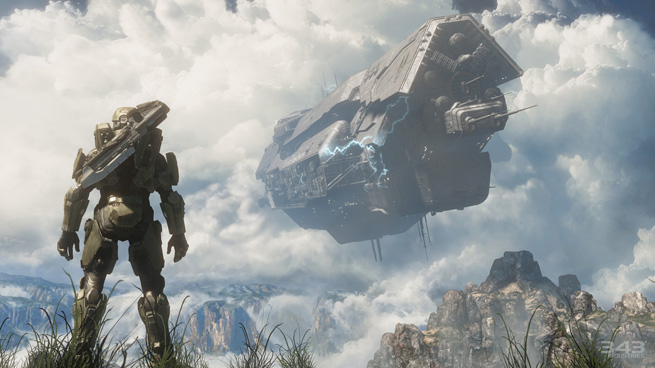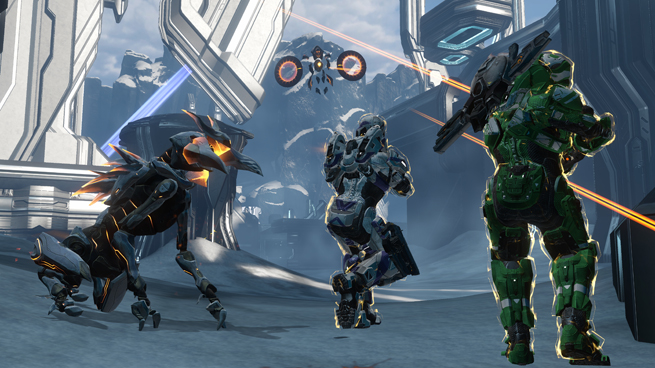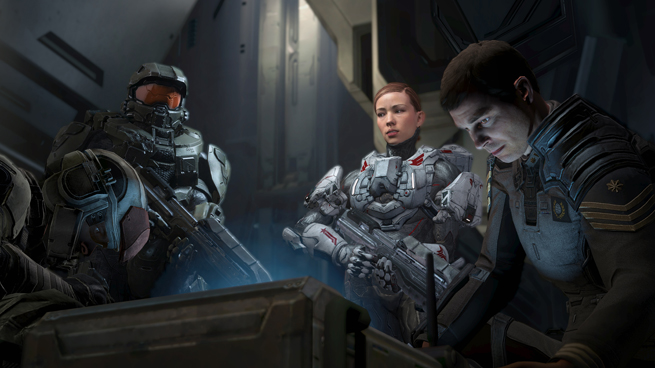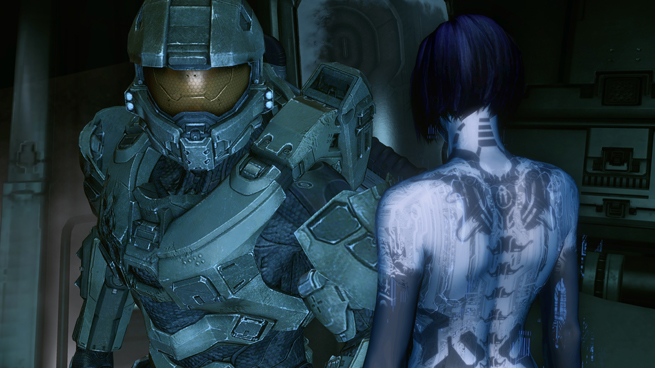The following review contains mild spoilers only.
In one of her increasingly rare moments of lucidity, Cortana — the sassy artificial intelligence who’s guided us through three iconic Halo games that have generated more than $3 billion in revenue for Microsoft — asks a favor: “If we get out of this, promise me you’ll figure out which one of us is the machine.”
Cortana is dying, an 8-year-old with a 7-year life expectancy. Her longtime partner, the Master Chief, makes her a different guarantee: We’ll fix you. Those aren’t empty words, either, coming from a man physically augmented and mentally conditioned from childhood to be humanity’s perfect soldier … possibly at the cost of his own humanity. Saving his last, best friend just represents the latest objective assigned to him. At first.
Unbreakable promises and questions about our very nature provide a strong foundation for Halo 4 (releasing November 6 for Xbox 360), the first in a new trilogy from largely untested developer 343 Industries. They also present an interesting metaphor. Expectations run high when you bring Halo into the conversation, and many people asked whether 343 could keep the magic alive without Bungie, the studio that created the Master Chief and made his war into Microsoft’s signature video-game franchise. Would the Chief survive the transfer from one creative team to another intact?
He did. Halo 4 keeps every promise it makes. The real question is whether you think it promised enough.
What you’ll like
Things change
A moment comes in Halo 4 when the Master Chief does something we’ve never, ever seen him do … something I never even thought he could do. The entire universe pivots in that instant.
We haven’t exactly gone without Halo anytime in the last decade, but it’s been five years since we last played as the Chief. It’s good to be home again. Even better, our pulpy space opera hangs on to the dramatic weight it found in Halo: Reach’s doomed last stand and makes the crisis personal. It hurts to see Cortana, one of the strongest women in gaming, so vulnerable and unsure, and her uncharacteristic glitches soon deteriorate into full-bore schizophrenic breaks. I actually hesitated a few times when the game prompted me to insert Cortana’s chip into, say, a weapons terminal.
But it’s entirely gratifying (and a little telling) to watch the Chief circle the wagons around her, back her to the hilt, and defend her against all comers even past the point where he probably should. This is new ground, and the choices they make push both characters in new, unexpected directions. That’s what I wanted. That’s what I got.
And we get to shoot things. The Master Chief’s tenuous plan to save his friend hits a snag when they’re pulled inside Requiem — a majestic, artificial world built by the ancient Forerunner race — along with a fanatical Covenant splinter group searching for a new god to worship. Turns out those zealots came to the right place. What the Chief and Cortana discover on Requiem puts mankind in the crosshairs of the Didact, an overwhelmingly powerful enemy with an eons-old grudge against our species. If you ever wanted to see the Master Chief completely helpless, the Didact will oblige you.
He also provides our new targets, and they are no joke. Prometheans come in three sizes (pack-animal Crawlers, hovering support unit Watchers, and heavily armed, heavily shielded Knights), but they operate as one interconnected unit. Forget jumping into a pack of them and shooting your way out. Prometheans defend, repair, and even spawn each other, so it’s crucial to apply some strategy in order to shut them down fast. I found popping Watchers from a distance usually made a reliable Step 1, but priorities change according to who’s killing you at the moment. Individually or in a squad, Prometheans make pleasingly dangerous adversaries.
Knights in particular are tough, tricky — they can teleport out of harm’s way if you start scoring on them — and imposing in ways Covenant forces just aren’t anymore, so it’s especially satisfying when you assassinate one. Game-wide, it’s roughly a 50-50 split between Prometheans and Covenant encounters, though it gets especially tense when both come at you at once.
So show up for the violence, stay for the story. Big things happen in this game. We see evidence of a resurgent humanity represented by the UNSC Infinity, a massive, fully-loaded dreadnaught also drawn inside Requiem. Hints drop about our race’s destined role as we march out among the stars. And watch the Master Chief’s body language closely. Something’s happening behind that expressionless visor.
Yes, the universe changes in Halo 4, and I’m eager to see where we go from here.
Looks good, feels better
Stepping up to your first vista of Requiem evokes a genuine sense of wonder and awe, not unlike the first time we walked out onto the surface of a Halo, aided in no small measure by the all-new graphics. Halo 4’s stunning visuals represent a quantum leap for the series and a serious bump on nearly any other game franchise you’d care to name. This game is endlessly beautiful.
That’s only the tip of the overhaul. 343 Industries took major cues from Call of Duty — current holder of Halo’s old first-person-shooter crown — to add a slightly more tactical edge to the familiar run-and-gun game, and everything feeds into that philosophy. It’s in the Prometheans’ rock-paper-scissors approach, the new grenade-warning indicator, the new armor abilities, and in how the best weapons in the Master Chief’s revised arsenal tend to be more precision-focused. The Chief even moves noticeably slower than before, balanced by a permanent sprint function. Man, does it feel different. But once you dial in, Halo 4 takes off.
For better and worse, I never dug into the short-burst Thruster Pack or enemy-scoping Promethean Vision (the range on both didn’t impress me). But a handy, deployable sentry turret and a mobile, hard-light shield became invaluable. I also clung to my scope-equipped Battle Rifle and the improved Designated Marksman Rifle (DMR) like never before. Seriously, I passed over energy swords to hang on to my iron. That’s unheard of in previous Halos.
But whatever you’re shooting, the audio design takes everything up a notch. No more mistaking assault rifles fired in the distance for misaligned typewriters. You bring thunder to a gunfight, and alien weapons truly sound alien.
343 retooled absolutely everything in the never-ending quest for balance. The Warthog jeep feels far less floaty; I actually enjoyed driving it. A lot of old favorites — Ghosts, energy swords, shotguns, jetpacks — feel slightly (and rightly) scaled back from their always-win status. New favorites abound. I grabbed any Sticky Grenade Launcher offered to me for the pure comedic value of remote-detonating my enemies. The Promethean Lightrifle (a super-cool Battle Rifle analogy) and sniperish, one-hit-kill Binary Rifle are definite keepers, though the SMG-style Suppressor seems too inaccurate. And I’d take a very scary squirt-gun over the Boltshot pistol any day.
On the other hand, picking up the ridiculously overpowered SAW, a BFG heavy rifle, pretty much puts you on par with God. That suited me fine in the campaign; less so in multiplayer.
Also overpowered is the heavily publicized Mantis combat mech. It comes in handy when a few squadrons of Banshees strafe you, but it doesn’t distinguish itself from any other recent gun-heavy mobile suits (Mass Effect 3, Gears of War 3, etc.). You hop in and fire barrages of missiles at one teeny little Grunt. Because you can. I actually preferred getting behind the stick of a Pelican for the first time in the series’ history. That’s some long-deferred wish fulfillment … even if that sequence feels more like a reward for my patience than an actual challenge. I like rewards.
You get a lot of them in Halo 4. The rhythms differ, and the sexy looks are a surprise, but the gameplay feels at all times tight, precise, and joyous.
Particularly once you fire up the multiplayer.

Multiplayer 5.0
For their first bite at Halo’s famed multiplayer, 343 split things up into competitive War Games and cooperative Spartan Ops, borrowing again from Call of Duty (specifically, its Spec Ops mode).
The latter might be the more interesting animal. Spartan Ops takes a four-player co-op game (while allowing for solo runs) and breaks it into a 10-part episodic series complete with its own characters, cutscenes, and a narrative arc that sends the UNSC Infinity back to Requiem six months after the campaign’s events. A new downloadable episode featuring five missions (no recycled assets, we’re told) will drop every week, free to anyone with a copy of the game and an Xbox Live Gold account.
It’s tough to judge Spartan Ops at this point. I blitzed through the first episode — the only one available for review — in little over an hour and found the missions diverse but uneven. At best, it handed me a quick-hit series of objectives with a well-thought-out progression and nicely varied challenges over wide-ranging maps. At worst, it locked the room and threw monsters at me. Hopefully, the other 9 episodes will capitalize on the potential.
[vb_gallery id=562017]
Meanwhile, War Games zeroes in on the solo and team firefights Halo devotees show up for, set on mostly new maps. Ragnarok merely repaints Halo 3’s popular Valhalla with Halo 4’s brush and adds a bonus Mantis, but the rest are first-timers, and most offer rich possibilities. Some even feel tailor-made to specific modes. King of the Hill belongs on Haven, my favorite of the collection — an airy, two-story donut with a chewy, tough-to-defend center. I never enjoyed SWAT’s hardcore ways (or, coincidentally, repeated death and humiliation) until I took the new DMR through Settler’s idyllic, green murder hills and sneaky flanking cave. Call me a convert.
That specificity follows into two new game types, each deserving to become standard issue not only in future Halos, but in completely different franchises.
Regicide’s advanced free-for-all stands out from the pack, tagging the top-scoring player with an always-visible waypoint and an ever-increasing bounty. It’s an elegant autobalancing system, guaranteeing constant pressure on the leaders while opening the door wide for midrange players to pull off last-second, come-from-behind wins. And Extraction tweaks the standard control-points games by sending teams to capture and hold nodes until they “extract,” banking the point. That’s when more nodes randomly spawn on the map, and everyone goes nuts breaking enemy-held nodes, defending their own, or rushing to capture new ones. It’s a perfect fit for Meltdown, a figure-eight map that balances lots of space with lots of shortcuts.
But details sell the carnage better than ever before. Contextual music gets the heart thumping. Call of Duty-style ordinance drops come online at a satisfying clip. Hit a button to skip the respawn counter (and a kill-cam replay of your untimely death) and jump back into the action. Everything’s waypointed; teammates who have grabbed an enemy flag pop up with an “Escort” or “Protect” tag. Scumbags making off with your flag are marked “Kill.”
And finally, finally, Halo’s player customization makes it into the Modern Warfare era. Bling out your armor if you want, but the focus stays on unlocking and customizing up to five loadouts (transferable to Spartan Ops), complete with Tactical Package/Support Upgrade perks such as fast reloads, infinite sprinting, and bigger grenades. I built loadouts geared not only toward my play style, but specific to certain game modes. Spray-‘n-pray guns and heavy defense for King of the Hill. Scoped weapons and decoys for Regicide.
It makes all the difference. I’m playing my Halo, my way. The matches feel more interesting, too, as very different players bring very different (but still fairly balanced) Spartans to the fight.
Maybe the team at 343 just moved the needle here, but they moved it well. However, if you felt done with the series after Halo: Reach, odds are you’ll decide they didn’t move it far enough, and that applies across the board.
What you won’t like
Things stay the same
343’s biggest misstep, if you consider it one, is that it successfully created the next chapter in the Halo saga by sticking to known formulas. In fact, veterans of Halos past will experience déjà vu concurrently and consecutively throughout Halo 4’s eight playable levels (bookended by nonplayable story chapters) and possibly deep into Spartan Ops, as well. Only occasionally does it feel like Halo’s showing you something completely new — at least, something new to Halo.
I started ticking off a mental checklist. Breakneck vehicular escape as the world explodes around you? Check. Scorpion tank section where you go sickhouse on the puny aliens? Double check. Can you ride a huge gondola through various ambushes? You can. Want to crawl through another sniper alley? You will. Do Covenant forces still love to fortify narrow bridges spanning bottomless chasms? They do. Who wouldn’t? And yes, Halo continues to rely heavily on mission structures that send you across enemy-infested territory to flip two or three switches before you can accomplish what you really wanted to do. Later variations on the “just one more!” message won a few eye rolls from me.
That said, the design of those individual encounters — right down to the mix, placement, and tactics of enemies — always gives you something meaty to bite into, and the overall flow hits a sweet spot few other games even reach for. You rarely find yourself stuck doing the same thing in the same way for long. Sure, it might feel familiar, but a reliably brisk pace always kept me sprinting for the next challenge with a malicious grin on my face.
Oh, and about that multiplayer. …
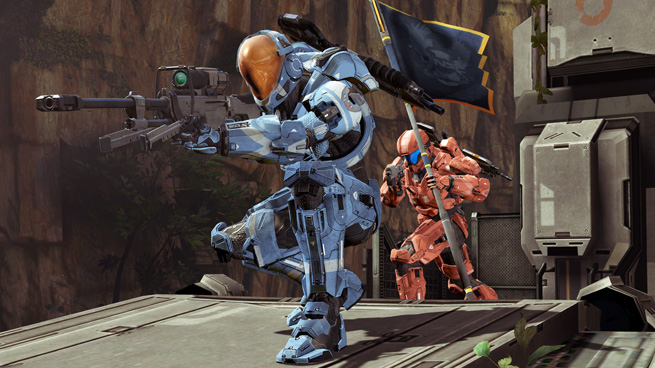
Multiplayer 5.1, please?
I get the sense that War Games’ multiplayer havoc would have benefited from an open beta and a few more general-purpose maps. Halo: Reach actually launched with fewer arenas to hunt in, but the specificity I mentioned earlier cuts two ways. A good chunk of Halo 4’s rumble pits feel narrowly defined or simply ill-suited to the more entertaining game types. Regicide works brilliantly on close-quarters maps like Adrift — full of tight corridors and a central area I lovingly dubbed “the kill box” — or Haven. In larger areas — like Longbow, Exile, Meltdown, Complex, or Ragnarok — the fun simply shuts down.
And 343 possibly forgot that some people don’t play well with others. Abandon’s sticky jungle and overgrown, three-tiered base makes a great setting for Flood (the slightly revised Infection, where good Spartans become bad mutants on death), but it’s Camping World for Slayer or SWAT matches. Spawn-in points sit right out in the open, in prime sniper-bait locations. Believe me, I frequently ended up on both the giving and receiving ends of that equation. You really can’t help it. Exile lets you merrily camp spawn points in a tank.
Match the right game mode to the right map, and you’re in for a high-caliber experience in every sense — nobody’s camping anybody on Exile during a fast-moving round of Extraction. And the Forge returns with enough new options and toys to keep the DIY crowd salivating at the possibilities for years. But a few post-release refinements are definitely in order, and I would’ve preferred more equal-use ground without needing to build my own or sink money into downloadable map packs.
Plot ex machina
The entire arc between the Master Chief and Cortana plays out beautifully. The backstory explaining the Didact’s genocidal crusade doesn’t fare quite so well.
That half of the plot requires you to internalize a few shattering revelations about the human race that characters casually toss out and accept as if discussing a particularly dull breakfast cereal. It doesn’t help how, unlike Cortana’s slow burn, we get that info dump in one mid-game scene, and then it’s off to shoot more Covenant before we can figure out what a Composer’s for or what “the Mantle” means. My review agreement with Microsoft politely asks that I don’t talk about “the specific role of the Cryptum.” No problem. I have no idea what that is.
(Of course, if I’d read the Halo novels by Greg Bear, this would all be crystal clear. But I haven’t, I don’t plan to, and I shouldn’t need to if the game’s doing its job properly.)
I also have to admit that some of the game’s best story moments hinge on one of the worst plot contrivances out there: the officer who’s clearly too foolish, cowardly, and hysterical to ever win command of humanity’s flagship.
These aren’t new problems for Halo; less than half of the Halo 2 players I meet can accurately describe that game’s twisty plot nuances. And in fairness, terminals scattered throughout the levels unlock cutscenes that fill in a lot of narrative blanks. We get an ugly, up-close lesson on the Composer later on. Over a decade after Halo first used the term, we even learn why humans are “reclaimers” and what we might reclaim.
But at some point, 343 Industries (and game designers in general) must stop treating its epic tales like a bunch of collectible items. If it truly matters, stop hiding the pieces, commit players to the path, and tell the damn story.
Conclusion
Halo 4 constantly ups the ante in smart, satisfying ways. Everything might’ve changed under the hood, but 343 did what it set out to do: make a Halo that can stand tall with Bungie’s revered classics. That’s no mean feat. If you want numbers, you get two 8-10 hour campaigns plus a deeply involving multiplayer. That’s a hell of a lot of game for your dollar. Not a Gold member? Wait until mid-January, shell out $10 for a month’s access, and nab all the Spartan Ops episodes in one go. Consider that my sound economic advice.
It’s unfortunate that 343 didn’t stretch past the standard Halo playbook instead of falling back to so many recognizable gameplay beats (and I do wonder if that was a conscious decision meant to counter the “Will it be Halo?” doubters), but the gameplay itself offsets those issues. The level design is a precision instrument. Above and beyond that, Halo 4 expertly folds an intimate story into an epic scope, taking risks with iconic characters and sticking the landing every time. The Master Chief was heroic before. Now he’s a hero.
Next time, I’m expecting legendary.
Score: 90/100
(See our interviews with Josh Holmes, creative director, and David Berger, technical director.
Halo 4 releases November 6, 2012 for the Xbox 360. GamesBeat participated in a two-day review event hosted by Microsoft in San Francisco for the purpose of this review. The publisher also provided copies of the game to GamesBeat.
VentureBeat's mission is to be a digital town square for technical decision-makers to gain knowledge about transformative enterprise technology and transact. Learn More


